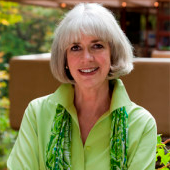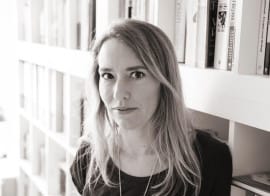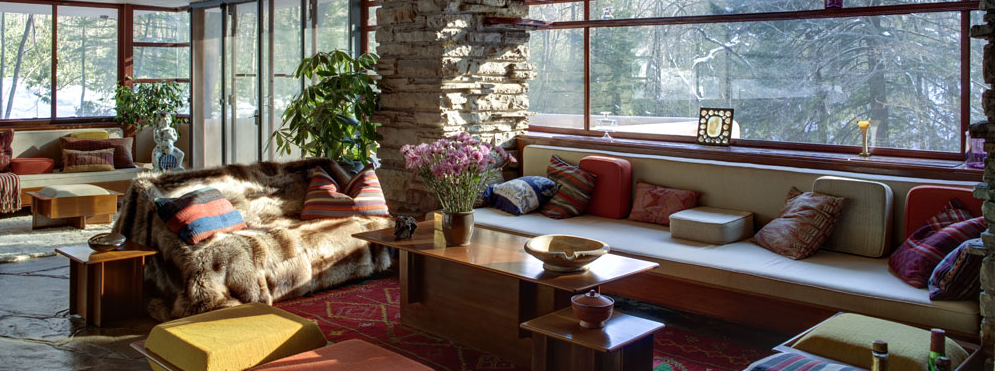‘It’s a very powerful building, and a moving experience’

Lynda Waggoner
Interview with upcoming guest Lynda Waggoner
Lynda Waggoner is the director of Fallingwater, a Pennsylvanian house designed in 1935 by the renowned American architect Frank Lloyd Wright (1867–1959). She is speaking at the John Adams Institute on May 12th at an event hosted at the museum Het Grachtenhuis.
What is it that makes Fallingwater so special?
Fallingwater is Frank Lloyd Wright’s house built over the waterfall in Pennsylvania, and it’s arguably the most famous house of the modern era. I think it’s Wright’s consummate example of architecture connected to nature, a component of what he called ‘organic architecture’.
It was originally constructed as a private residence?
It was, for the department store owner E.J. Kaufmann and his wife. In 1963, it was donated to a private non-profit organization in the United States called The Western Pennsylvania Conservancy, which is primarily a land conservation organization. It was maybe one of the first, if not the first, modern house to come into the public domain, essentially as a house open to visitors.
What is involved in the caretaking of a building like this?
Well, it’s a modern building, and as in most significant modern buildings, Wright as an architect stretched technology and design in creating it. When you do that, you typically have a lot of issues with the building; in Fallingwater it ranges from leaky roofs to failing cantilevers. There’s also the issue of having a flat roof in a northern climate. And building over a waterfall presents a particular challenge in terms of location, so there are all kinds of things we have to address at Fallingwater. Plus, we have a big landscape to care for: over five thousand acres.
Moreover, we have about 160,000 people visiting the building each year. In the busy season that means 14 people going through the front door every six minutes.
Is it a challenge to preserve the artistic integrity of the building with those kinds of issues?
Yes, we’re very conscious of the issue and we strive to do that all the time. We don’t like having to change anything – to be sure, we’d never put a pitched roof on Fallingwater just to shed water, or something like that, but we are employing modern roofing technology to better address the roof problems.
What is it that appeals to you personally about this house?
Like any masterpiece, it’s a building that you never tire of; it’s so complex that you find new things in it all the time. But, I also think it speaks to us on a number of levels. It speaks to us intellectually, just in the composition and the brilliance of it, but also in a very visceral way. People from all walks of life love it. It’s admired not just by architects and architectural historians, but also the average person. It’s a very powerful building, and a moving experience.
Do you think the building’s relationship with nature can inspire future constructions?
Yes, I think it can because it remains inspiring. I’m amazed it was ever able to be created! Wright grew up on a farm, and I think he had a keen understanding of and a great respect for nature. American architecture has always been rooted in nature, although now you could not build Fallingwater in the United States: you’d never be able to build that close to a stream. Actually Fallingwater has had no impact on the stream, because he never blasted any of the rock. Instead he used bedrock as the foundation and then suspended it over the stream. Nevertheless, today you just would not be allowed to even consider such a location for a house.
Have there been any changes to the surrounding nature because of Fallingwater?
No negative ones. I think the fact that the building came into the public domain actually protected the stream, because our organization continued to buy land around it, and it became the first exceptional value stream in the state of Pennsylvania. It’s a very pristine stream.
You yourself have a long relationship with the building.
I’ve been the director since 1996, but I was the first curator at the site, beginning in 1986. But even before that, I grew up in the area and as a high school and college student, I worked there during summers. So, it’s been a life’s work and a great privilege and joy to work there.
What have you learned, as you’ve gotten to know Fallingwater better?
Well, you learn its quirks, and you also learn how to best present it. Take the importance of the textiles. If you took all the decorative arts out of the building, it would become cold – after all, it’s concrete, stone, steel and glass! The textiles give it visual warmth and also speak to a certain style and period of time. The placement of art in the building is also really important to how you see the house, and how it points out relationships within the building.
I’ve also been very concerned over the years to prevent it from becoming too institutional looking – you know, signage proliferates, because people always think ‘oh, we’ll just add another sign’, but it changes the character of the site.
Is it just as complex as a person, too, then?
I think that’s what people are most surprised about when they come to visit; they had no idea how complex it is. Because the classic view – over the waterfall – is not what you see when you first come to the site. Visiting in person one has a very different experience of the building. In the summer, when the leaves come out on the trees, it closes in a bit. In the winter, it opens up, and it’s stunningly glorious when the waterfall freezes over. When it rains, the rain falls off all the roof ledges, and that too can be a very different and charming experience. Then, in autumn, we have great fall color. It expresses itself differently, like it’s putting a new suit on every season.

Katherine Oktober Matthews
Buy tickets for Lynda Waggoner’s talk for the John Adams Institute on May 12, 2016 at 8:00 pm, at Museum Het Grachtenhuis in Amsterdam at https://www.john-adams.nl/lynda-waggoner/
Katherine Oktober Matthews is an American artist based in Amsterdam. She is the Chief Editor of GUP Magazine. For the John Adams Institute she interviews upcoming speakers. See more of her work at oktobernight.com.
